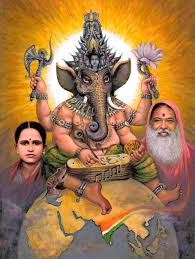Narayana
Maharishi Śuka continued, “Dvimanta was also renowned as Kuvalyayāśva, Satrujit, Rtadhwaja and Vatsa. Alarka and other sons were born to him”.
The Kuvalayaśva whom we speak about in Datta Darśanam is this person!
“Alarka ruled the earth for sixty-six thousand years. None other than him has ruled the earth for this long period of time. Santati was the son of Alarka. His son was Sunītha whose son was Suketana. Suketana’s son was Dharmaketu. His son was Satyaketu. Satyaketu’s son was Dṛṣṭaketu. His son was Sukumāra. Sukumāra’s son was Vītahotra. Vītahotra’s son was Bharga. Bharga’s son was Bhārgabhūmi. All these descendants of Ayu’s son Kṣtravṛddha, belonged to the lineage of Emperor Kāśi.
Āyu’s another son was Rambha. His son was Rabhasa whose son was Gambhīra. Gambhīra’s son was Akriya. From the womb of Akriya’s wife, the lineage of Brahmins came into existence.
Now I shall explain the lineage of Āyu’s another son Anēna. Listen. Anēna’s son was Śuddha. His son was Śuci. Śuci’s son was Triśakat. His son was Dharmasārathi. Dharmasārathi’s son was Śāntaraja. He was a Self-realized liberated person.
Āyu’s yet another son was Raji. He had 500 powerful sons. In response to the pleas of the Devatas, Raji defeated the demons and restored heaven to Lord Indra. However Indra, who was terrified of mighty demons such as Prahlāda, held on to Raji’s feet and surrendered totally to him.
After Raji’s demise, his 500 sons refused to hand over heaven to Lord Indra, even after repeated requests. To add to it, they even began to accept the oblations offered during Yagnas to Indra.
Guru Brihaspati then performed a fire ritual with the intent that Indra should emerge victorious. With this Indra was able to easily kill the sons of Raji, who had deviated from the path of righteousness. Not even one among them survived.
Kṣtravṛddha’s grandson was Kuśa. His son was Prati. Prati’s son was Sanjaya whose son was Jaya. His son was Kṛta. Kṛta’s son was Hāryaman. Hāryaman’s son was Sahadeva whose son was Hīna. His son was Jayasena. Jayasena’s son was Sankṛti. His son was Jaya who acquired great renown among the Kṣatriya clan. He was a great warrior. All these emperors belonged to the lineage of Kṣtravṛddha.
Now I shall narrate the lineage of Nahuśa, another son of Āyu” said Maharishi Śuka.
With this the seventeenth chapter of the ninth canto comes to an end.
Ninth Canto Chapter Eighteen
In this chapter, the story of Yayāti has been narrated. It is very important to listen to this story.
Maharishi Śuka continued, “Just as all living entities have six senses known as eyes, ear, nose, tongue, skin and mind, King Nahusha had six sons Yati, Yayāti, Samyāti, Āyati, Niyati and Kṛti. Nahuśa handed over the responsibility of the kingdom to Yati.
However Yati was disinclined towards accepting the kingdom as he was aware of the responsibilities that come along with it. Moreover a person who is immersed in managing the affairs of the kingdom can never understand his true Self, isn’t it? Where is time for penance for a king? He therefore rejected the kingdom.
At one point of time, Nahusha was attracted towards Indra’s wife Sacidevi and desired to marry her. As a result of this sin, he was cursed by Agastya and other Maharishis. He lost his position as the Lord of heaven and fell down. At this juncture, Yayāti took over the reins of the kingdom.
Emperor Yayāti positioned his four brothers in the four directions and asked them to rule. He married Devayāni, the daughter of Śūkracharya. He also married the daughter of the demon-king Vṛṣaparva and ruled the entire kingdom”.
Hearing this, Emperor Parikshit enquired, “O Maharishi! Śūkrācharya was a supreme Brahmin. Nahuśa’s son Yayāti belonged to the Kṣatriya (warrior) caste. How could a Kṣatriya marry a Brahmin lady? What was the reason behind this? I am curious to know.”
Maharishi Śuka replied, “Demon-king Vṛṣaparva had an exceedingly beautiful daughter called Śarmiṣṭha. One morning she was leisurely walking in the palace gardens along with Devayāni, the daughter of Guru Śukracharya. She was accompanied by her thousand female attendants. This garden was replete with bunches of colourful flowers. The bees that were encircling the lotuses in the lake were buzzing melodiously.
The lovely eyes of these beautiful maidens resembled the long lotus petals. Leaving their clothes on the banks of the lake, they were engaged playfully in the waters splashing water upon each other.
At that moment Lord Śiva, the resident of Kailāsa, passed by. He was accompanied by Mother Parvati. They both were seated on vehicle Nandi. Upon noticing ŚĪva, the girls hastily rushed to the shore and covered themselves with their clothes. In that confusion, Śarmiṣṭha failed to recognize Devayāni’s clothes. She wore Devayāni’s sari by mistake.
Devayāni was angered by Śarmiṣṭha’s deed. She rebuked, “Aha! What a condemnable deed this girl has committed! Just as a dog snatches the oblations meant for Yagna, this girl has worn my clothes.”
In that era they loved dogs and reared them. But if the dog would touch any food or other items during Yagna, the items would be discarded as unworthy.
“Learned Vedic Brahmin scholars have created this world using their mystical powers. Such Brahmin scholars are said to be the face of the Supreme Lord. These Brahmins retain the Supreme Lord within their hearts. They show the auspicious path called Vedic path to the citizens”.
In that era, the Brahmins were engaged in Yagna and related activities and hence would consider themselves distinct from others. In this era however, all of us are one and the same.
Narayana
